
The National Palace Museum, is a museum in Taipei, Republic of China (Taiwan). It has a permanent collection of nearly 700,000 pieces of Chinese artifacts and artworks, many of which were moved from the Palace Museum in the Forbidden City in Beijing, as well as five other institutions throughout mainland China during the ROC retreat. These collections had been transferred to several locations before finally being established in 1965 at its present location in Shilin, Taipei. The museum building itself was built between March 1964 and August 1965, with many subsequent expansions making it one of the largest of its type in the world. There is also a Southern Branch in Taibao, Chiayi which opened in 2015.

Chinese art is visual art that originated in or is practiced in China, Greater China or by Chinese artists. Art created by Chinese residing outside of China can also be considered a part of Chinese art when it is based in or draws on Chinese culture, heritage, and history. Early "Stone Age art" dates back to 10,000 BC, mostly consisting of simple pottery and sculptures. After that period, Chinese art, like Chinese history, was typically classified by the succession of ruling dynasties of Chinese emperors, most of which lasted several hundred years. The Palace Museum in Beijing and the National Palace Museum in Taipei contains extensive collections of Chinese art.

Chinese culture is one of the world's oldest cultures, originating thousands of years ago. The culture prevails across a large geographical region in East Asia and is extremely diverse, with customs and traditions varying greatly between provinces, cities, and even towns. The terms 'China' and the geographical landmass of 'China' have shifted across the centuries, with the last name being the Great Qing, before the name 'China' became commonplace in modernity.
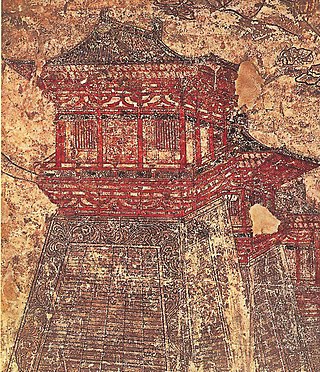
Chang'an is the traditional name of Xi'an. The site had been settled since Neolithic times, during which the Yangshao culture was established in Banpo, in the city's suburbs. Furthermore, in the northern vicinity of modern Xi'an, Qin Shi Huang of the Qin dynasty, China's first emperor, held his imperial court, and constructed his massive mausoleum guarded by the Terracotta Army.

Chinese tea culture includes all facets of tea, both physical and spiritual, that significantly influenced Chinese culture throughout history. Physically, it consists of the history of tea cultivation, brewing, serving techniques, methods of consumption, arts, and the tea ceremony. Tea culture is to take tea as a carrier, and through this carrier to spread various arts. Tea culture is an integral part of the excellent traditional Chinese culture, and its content is very rich. Tea culture is the organic fusion of tea and culture, which contains and embodies the manifestation of a certain period of material and spiritual civilization. Tea culture is the combination of tea art and spirit, and the expression of tea art through Spirituality. It emerged in China in the Tang Dynasty, flourished in the Song and Ming Dynasties, and declined in the Qing Dynasty.
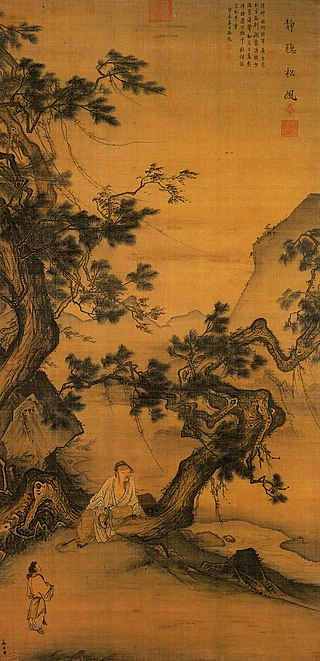
Chinese painting is one of the oldest continuous artistic traditions in the world. Painting in the traditional style is known today in Chinese as guó huà, meaning "national painting" or "native painting", as opposed to Western styles of art which became popular in China in the 20th century. It is also called danqing. Traditional painting involves essentially the same techniques as calligraphy and is done with a brush dipped in black ink or coloured pigments; oils are not used. As with calligraphy, the most popular materials on which paintings are made are paper and silk. The finished work can be mounted on scrolls, such as hanging scrolls or handscrolls. Traditional painting can also be done on album sheets, walls, lacquerware, folding screens, and other media.
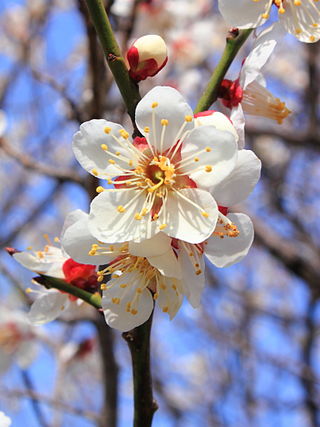
Prunus mume is a Chinese tree species classified in the Armeniaca section of the genus Prunus subgenus Prunus. Its common names include Chinese plum,Japanese plum, and Japanese apricot. The flower, long a beloved subject in the traditional painting and poetry of Sinospheric countries, is usually called plum blossom. This distinct tree species is related to both the plum and apricot trees. Although generally referred to as a plum in English, it is more closely related to the apricot. In East Asian cuisine, the fruit of the tree is used in juices, as a flavouring for alcohol, as a pickle and in sauces. It is also used in traditional medicine.

Tang dynasty art refers to Chinese art created during the Tang dynasty (618–907). The period saw significant advancements in arts such as painting, sculpture, calligraphy, music, dance, and literature. During the Tang dynasty, the capital city Chang'an, was the most populous city in the known world, and the era is generally regarded by historians as a high point in Chinese civilization and a golden age of Chinese literature and art.

A hanging scroll is one of the many traditional ways to display and exhibit East Asian painting and calligraphy. The hanging scroll was displayed in a room for appreciation; it is to be distinguished from the handscroll, which was narrower and designed to be viewed flat on a table in sections and then stored away again.

The Seven Sages of the Bamboo Grove were a group of Chinese scholars, writers, and musicians of the third century CE. Although the various individuals all existed, their interconnection is not entirely certain. Several of the seven were linked with the Qingtan school of Daoism as it existed in the state of Cao Wei.
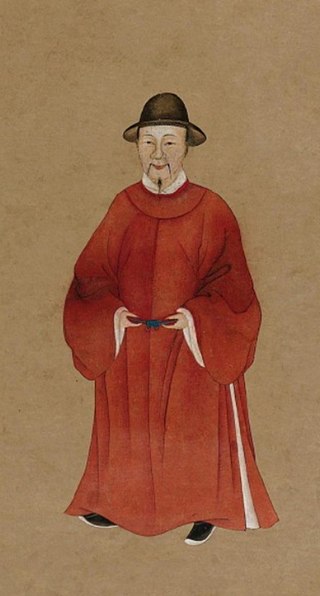
Tang Yin, courtesy name Bohu (伯虎), was a Chinese painter, calligrapher, and poet of the Ming dynasty period. Even though he was born during the Ming dynasty, many of his paintings, especially those of people, were illustrated with elements from Pre-Tang to Song dynasty art.

The Song dynasty was a culturally rich and sophisticated age for China. It saw great advancements in the visual arts, music, literature, and philosophy. Officials of the ruling bureaucracy, who underwent a strict and extensive examination process, reached new heights of education in Chinese society, while general Chinese culture was enhanced by widespread printing, growing literacy, and various arts.

Cizhou ware or Tz'u-chou ware is a term for a wide range of Chinese ceramics from between the late Tang dynasty and the early Ming dynasty, but especially associated with the Northern Song to Yuan period in the 11–14th century. It has been increasingly realized that a very large number of sites in northern China produced these wares, and their decoration is very variable, but most characteristically uses black and white, in a variety of techniques. For this reason Cizhou-type is often preferred as a general term. All are stoneware in Western terms, and "high-fired" or porcelain in Chinese terms. They were less high-status than other types such as celadons and Jun ware, and are regarded as "popular", though many are finely and carefully decorated.

The Admonitions Scroll is a Chinese narrative painting on silk that is traditionally ascribed to Gu Kaizhi, but which modern scholarship regards as a 5th to 8th century work that may or may not be a copy of an original Jin dynasty (266–420) court painting by Gu. The full title of the painting is Admonitions of the Court Instructress. It was painted to illustrate a poetic text written in 292 by the poet-official Zhang Hua (232–300). The text itself was composed to reprimand Empress Jia (257–300) and to provide advice to the women in the imperial court. The painting illustrates this text with scenes depicting anecdotes about exemplary behaviour of historical palace ladies, as well as with more general scenes showing aspects of life as a palace lady.

Much traditional Chinese art was made for the imperial court, often to be then redistributed as gifts. As well as Chinese painting, sculpture and Chinese calligraphy, there are a great range of what may be called decorative or applied arts. Chinese fine art is distinguished from Chinese folk art, which differs in its style and purpose. This article gives an overview of the many different applied arts of China.

Hanfu are the traditional styles of clothing worn by the Han Chinese. There are several representative styles of hanfu, such as the ruqun, the aoqun, the beizi and the shenyi, and the shanku.
Court Ladies Preparing Newly Woven Silk is a silk painting attributed to Emperor Huizong of the Song dynasty. It is the only extant copy of a lost original Court Ladies Preparing Newly Woven Wilk by Chinese artist Zhang Xuan. The painting depicts an annual imperial ceremony of silk production, held in spring. It shows three groups of Tang dynasty court ladies at work. Viewing from left, one figure sitting on the ground is preparing a thread and the other are sewing while sitting on a stool. The right group of four ladies are pounding the silk with wooden poles. The group stretching and ironing the silk and the right group which is pounding the silk with wooden poles are depicted in a diamond-shaped formation to produce the feeling of a three-dimensional space.

Qixiong ruqun, which can also be referred as Qixiong shanqun, also known as "chest-high ruqun", is a set of attire in hanfu, the traditional Chinese clothing worn by the Han Chinese. The qixiong ruqun is a unique style of ruqun, which is characterized with a high waistline qun, Chinese skirt. The qun used in the qixiong ruqun is generally tied above the bust level. It was worn by women during the Southern dynasties, Sui dynasty, Tang dynasty and Five Dynasties and Ten Kingdoms period. The style was also revived in the early and middle Ming dynasty.

After the fall of the Tang dynasty, the Khitan, a branch of the Eastern Xianbei tribes, established Liao dynasty in Northern China and Northeast Asia. The Liao dynasty comprised two regions: the Northern and Southern Divisions. The Northern divisions of Liao was mainly composed of tribal Khitan people while the Southern regions was composed of Han Chinese and other sedentary groups. The rulers of the Liao dynasty adopted a clothing system which allowed the coexistence of Han Chinese and Khitan clothing.
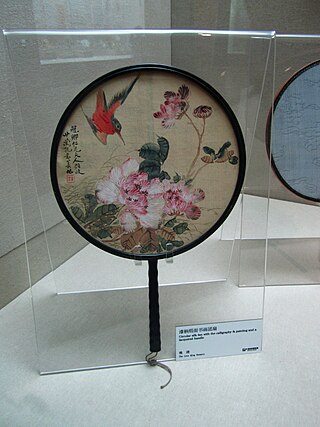
Tuanshan, also called gongshan, bian mian, fan of reunion, are typically silk rigid hand fan which originated in China; they are typically circular or oval in shape. Up to the Song dynasty, the tuanshan appears to have the most common types of the fans in China. These types of fans were mostly used by women in the Tang dynasty. Tuanshan with Chinese paintings and with calligraphy became very popular by the Song dynasty among court circles and artists and even continued to be in use even by the end of the 19th century. The tuanshan was also used as part of the traditional Chinese wedding and was part of the ceremonial wedding rite. They continue to be produced and sold in present-day China and has become a common form of accessory in Hanfu.



















